Transit
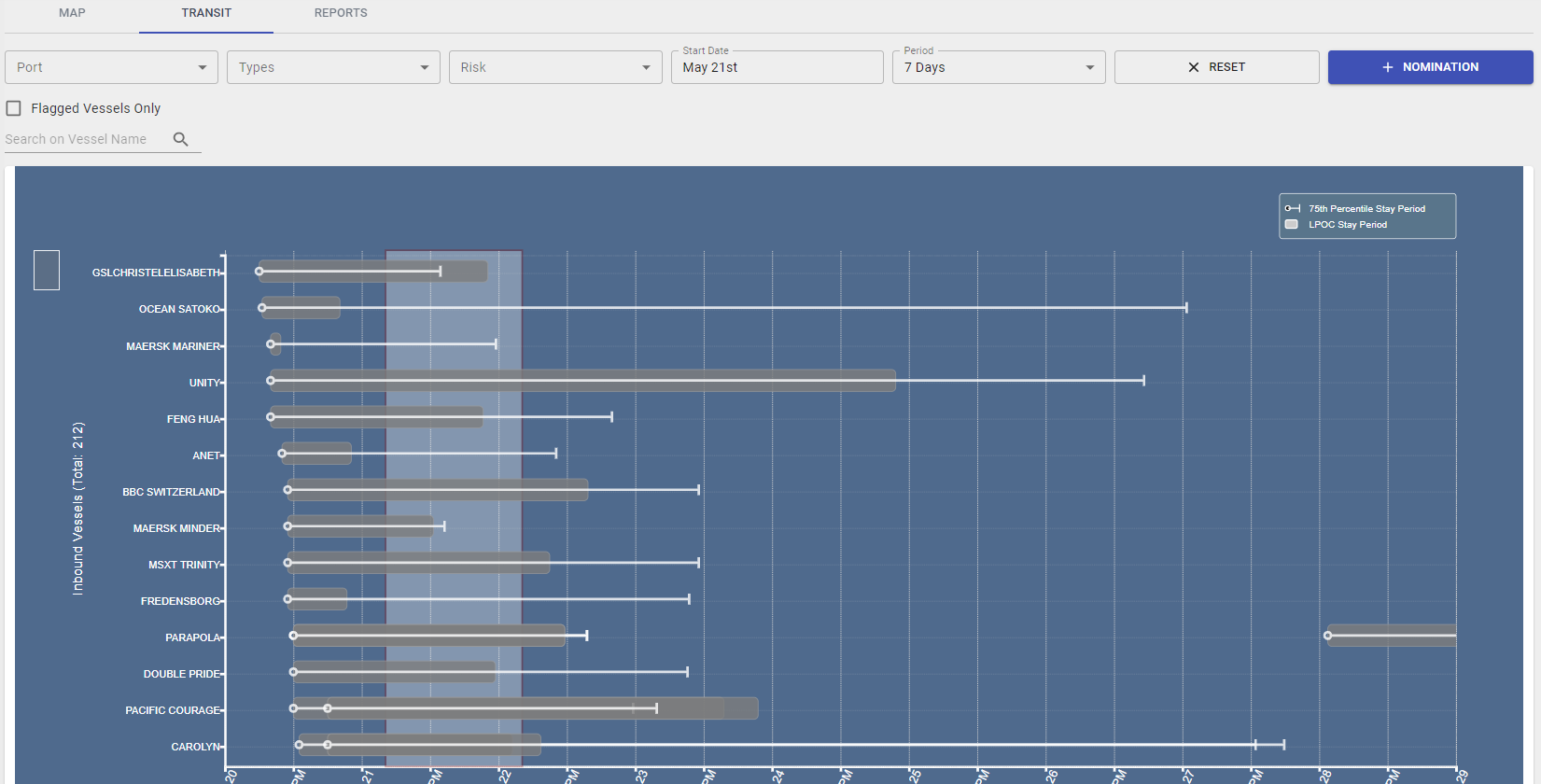
The Transit bar chart represents all nominations for all Vessels inbound to ports under a Regulator account.
Filter Transit

Filter the Transit table to view Vessels by
- Port - only ports that are allocated to the Regulator account will be listed.
- Types of Vessels
- Risk Category
- Start Date
- View Period
- Flagged Vessels Only
- Manual Nominations Only
- Search by Vessel Name
Step 1: Choose Port Location - only ports that are allocated to the Regulator account will be listed.

Step 2: Choose Type of Vessel from List.

Step 3: Choose Risk Category from List.

Step 4: Choose Start Date using the Calendar function.

Step 5: Choose View Period from List.

Step 6: Select Flagged Vessel Only to display only flagged vessels.


Step 7: Select Manual Nominations only to display any vessels with manual nominations.

Step 8: Search by Vessel Name to easily filter vessels.

View Vessel
The Transit chart will display all inbound Vessels to specified ports assigned to the Regulator user. Displaying both Biofouling Risk levels and Flagged Vessels.

Vessel Colour
- Grey - Unknown Risk
- Green - Low Risk
- Orange - Medium Risk
- Red - High Risk
Click on the Vessel to view Particulars.
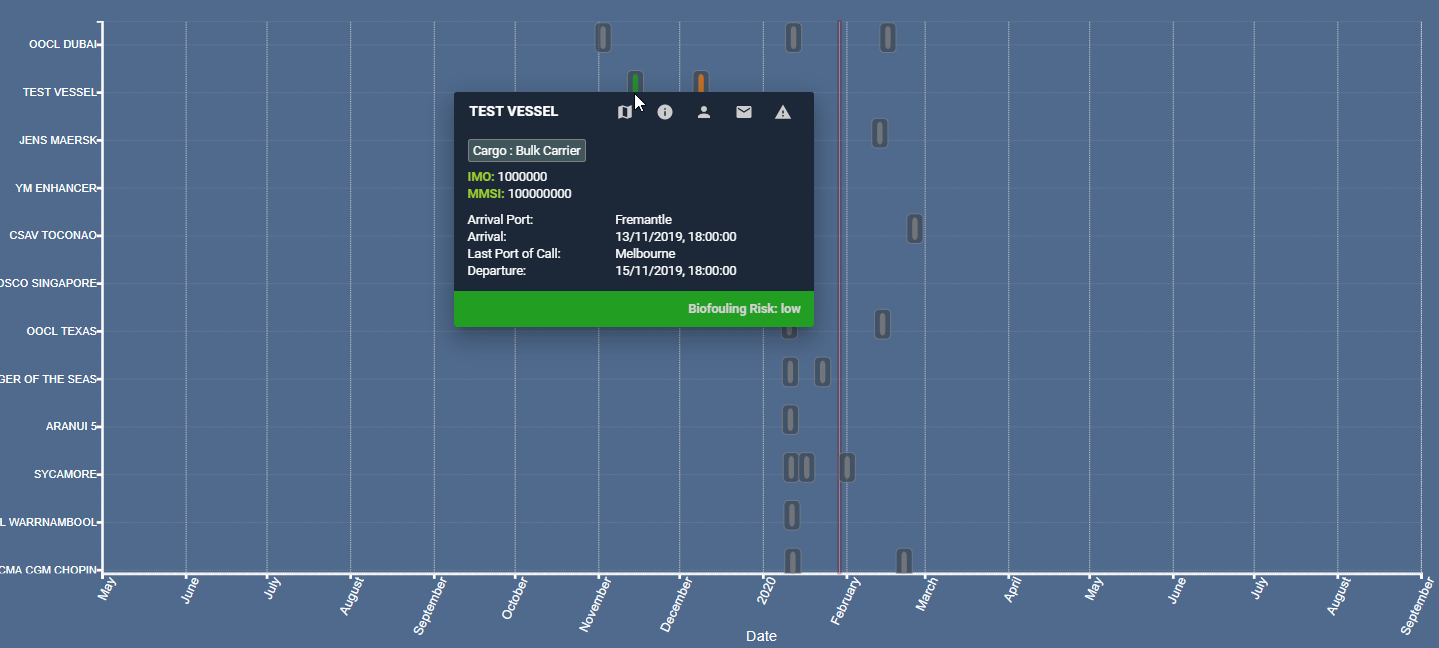
Map
Step 1: To View on Map, click Map Icon.
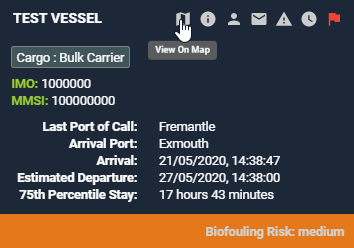
Step 2: The specific Vessel will be highlighted on the Map.
To utilise functionality of the Map view, please see the Map workflow.

Info
Step 1: Click on the Info Icon.
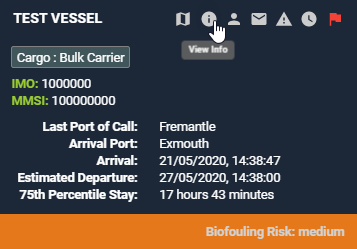
Step 2: The Info tab will display recent AIS data for the Vessel. Please note the Last Report data line, displays up to date AIS data that has been retrieved for the Vessel.

Change Status
Step 1: To Change the Status of the Vessel, click on the Verified button.

Step 2: Change Status of the Vessel as required.
Verified - Nomination is Verified and no further action.
Verification Pending - Nomination verification is pending.
Assign Intervention - Regulator to assign intervention for Vessel nomination.
Seek Clarification - Require further clarification about nomination.


Contacts
Step 1: Click on the Person Icon.
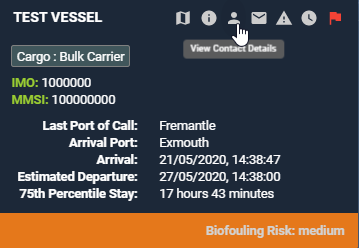
Step 2: Click Edit to edit Owner or Operator Details. Click Save and Close.
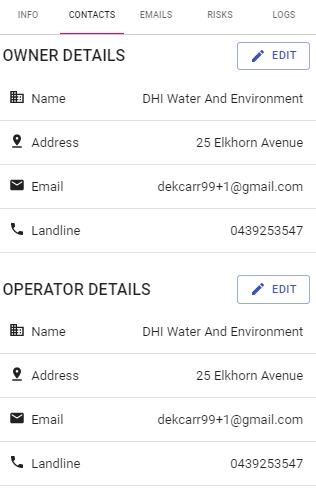

Emails
A communication log of sent emails will appear for each Nomination. To View sent emails, click on View Communications.


Compose Email
Step 1: Click Compose.
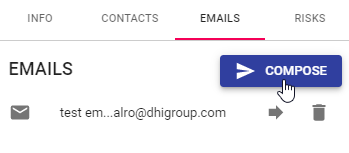
Step 2: Enter To, Subject and Message. Click Send.
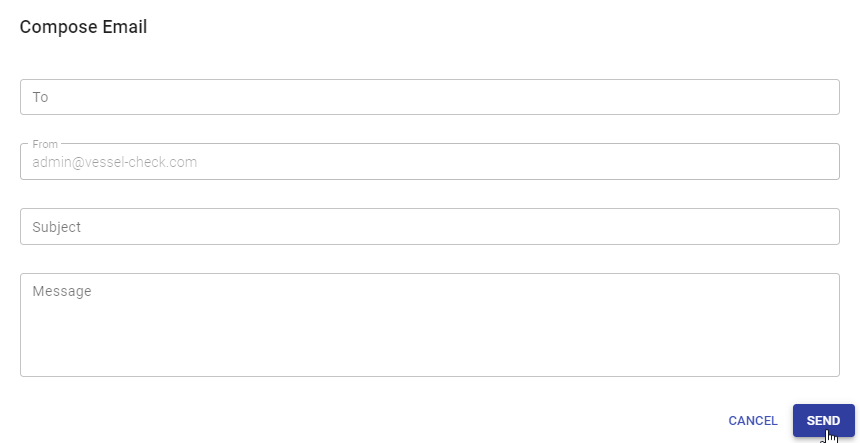
Forward Email
Step 1: Click on the Forward arrow icon.
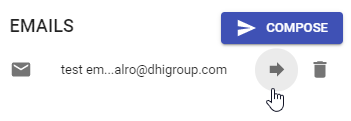
Step 2: Enter To and Subject. Click Send.

Delete Email
Step 1: Click on Bin Icon on specified email. The email will be deleted immediately.

Risks
Step 1: Click on View Risks icon.

Step 2: The Risks tab will display calculated Risk Reports.
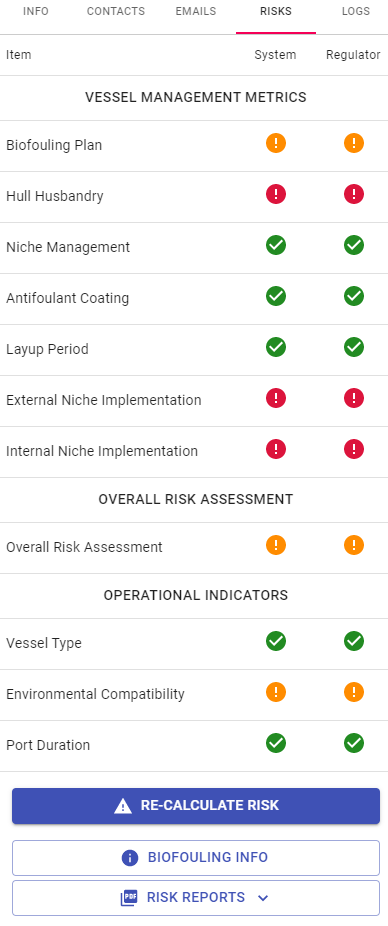
Operational Indicators
Immersion time is important for fouling accumulation, with organism settlement being restricted when in high flow conditions (e.g. when vessels are underway) (2). The duration of a vessel’s stay in a port can influence the overall risk of the vessel transferring an invasive aquatic species (IAS), as increased residence time increases the likelihood of fouling organisms settling on a vessel hull (2,3).
The Port Duration indicator within the Vessel-Check portal examines the period a vessel stayed in its 'last port of call' (LPoC) compared to the vessel's mean port stay duration. An extended stay at the LPoC beyond a vessels typical period of stay may indicate a greater likelihood of transferring an IAS to the destination port, especially if other aspects of the vessel’s biofouling management strategies are limited (e.g. expired antifoulant coating and/or no recent records of biofouling management plan implementation).

References
(1) Hopkins, G.A. and Forrest, B.M., 2008. Management options for vessel hull fouling: an overview of risks posed by in-water cleaning. ICES Journal of Marine Science, 65(5), pp.811-815.
(2) Davidson, I.C., Brown, C.W., Sytsma, M.D. and Ruiz, G.M., 2009. The role of containerships as transfer mechanisms of marine biofouling species. Biofouling, 25(7), pp.645-655.
(3) Sylvester, F., Kalaci, O., Leung, B., Lacoursière‐Roussel, A., Murray, C.C., Choi, F.M., Bravo, M.A., Therriault, T.W. and MacIsaac, H.J., 2011. Hull fouling as an invasion vector: can simple models explain a complex problem?. Journal of Applied Ecology, 48(2), pp.415-423.
Environmental Compatibility
The likelihood of impacts from an invasive aquatic species (IAS) is positively related to its ability to thrive in the receiving environment (1). Environmental matching (or similarity)* does provide a base indication of the potential threat a vessel may pose in transferring an IAS into the receiving jurisdiction (2). The Vessel-Check portal assesses the environmental compatibility between the Last Port of Call (LPoC) and the Destination Port (DP) by examining the similarity between environmental parameters of chlorophyll a (Chl a) (3) and sea surface temperature (SST) (4). Chl a and SST tolerances are known to be two of the key factors in determining an aquatic species range (1, 5). The portal examines the long-term monthly average Chl *a* and SST of the LPoC and DP for the arrival month of the vessel (when entering a jurisdictions port); where high environmental compatibility indicates a greater likelihood that a potential IAS could establish.
* species-traits which influence establishment likelihood are not accounted for within the metric.

References
(1) Keller, R. P., Drake, J. M., Drew, M. B., & Lodge, D. M., 2011. Linking environmental conditions and ship movements to estimate invasive species transport across the global shipping network. Diversity and Distributions, 17(1), 93-102.
(2) Campbell, M.L. and Hewitt, C.L., 2011. Assessing the port to port risk of vessel movements vectoring non-indigenous marine species within and across domestic Australian borders. Biofouling, 27(6), pp.631-644.
(3) https://resources.marine.copernicus.eu/documents/PUM/CMEMS-OC-PUM-009-ALL.pdf
(4) https://resources.marine.copernicus.eu/documents/PUM/CMEMS-INS-PUM-013-001-b.pdf
(5) Barry, S.C., Hayes, K.R., Hewitt, C.L., Behrens, H.L., Dragsund, E. and Bakke, S.M., 2008. Ballast water risk assessment: principles, processes, and methods. ICES Journal of Marine Science, 65(2), pp.121-131.
Inherent Vessel Risk
Certain vessels can have an inherent biosecurity risk resulting from the nature of their operations (e.g. dredges due to their contact with the seafloor) and/or the inability of a vessel to undertake proactive biofouling management (e.g. oil rigs due to the excessive cost associated with the application of an antifoulant coating (AFC) to such an intricately large structure). If appropriate, jurisdictions can apply a level of the inherent risk associated with a particular vessel type(s). The indicator in the Vessel-Check portal intends to encourage direct liaison of the particular vessel type(s) (deemed to have an inherent risk) directly with the biosecurity management agency to ensure a proactive management solution is achieved. By default this indicator is disabled (returns a low risk), it can easily be enabled to suit a jurisdiction’s requirements.
Re-calculate Risk
Step 1: Click Re-calculate Risk button.

Step 2: Any updates to the Risk Report will be displayed.

View Biofouling Info
Step 1: Click View Biofouling Info button.

Step 2: View Biofouling Management particulars for the Vessel. Regulators are unable to alter this information.
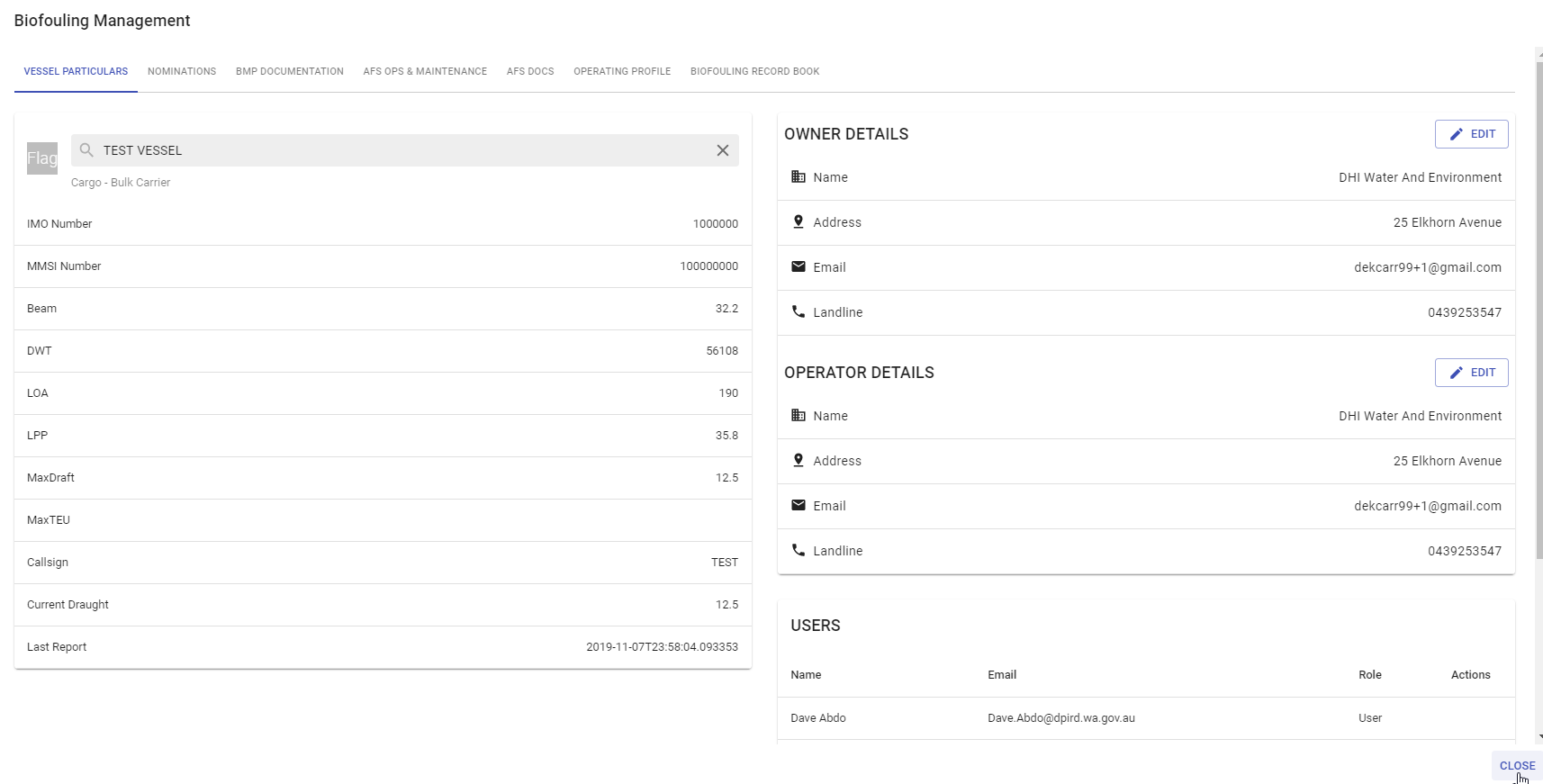
Download Risk Report
Step 1: Click Download Risk Report. Choose from the Vessel Manager Risk Report or the Detailed Risk Report.


Step 2: The report will be downloaded as the chosen PDF.
Vessel Manager Risk Report
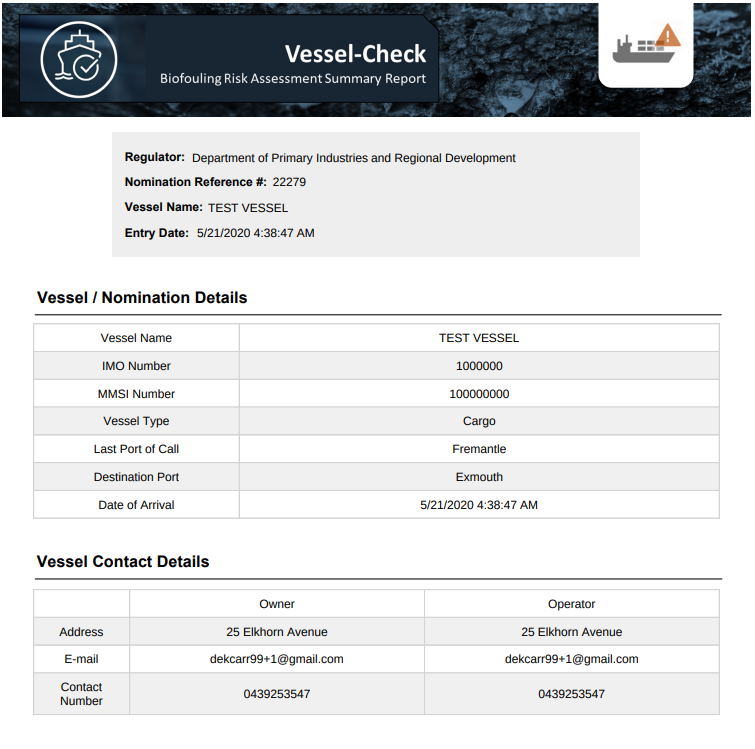

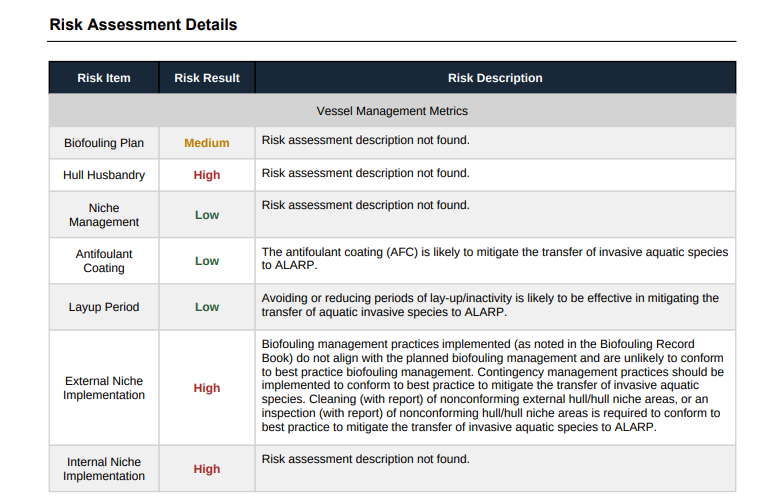
Detailed Risk Report
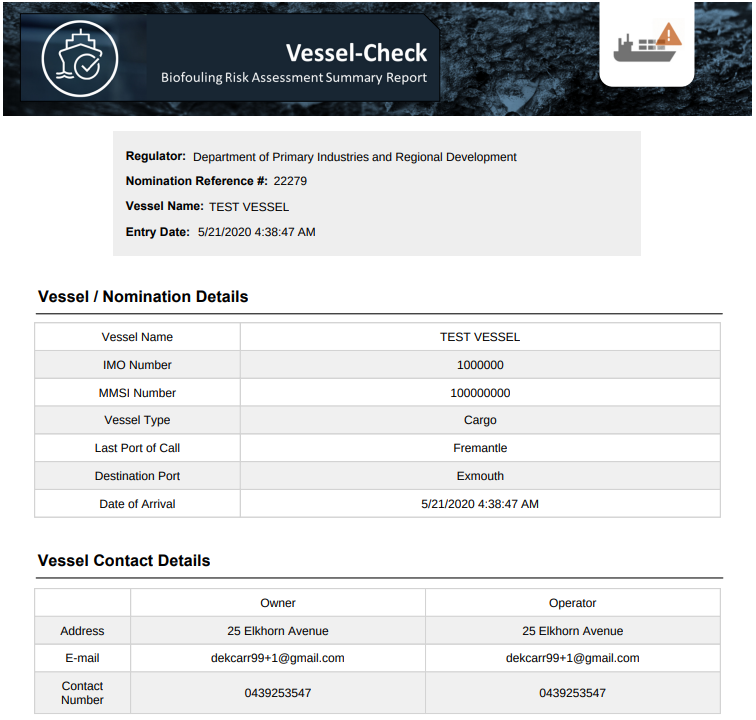

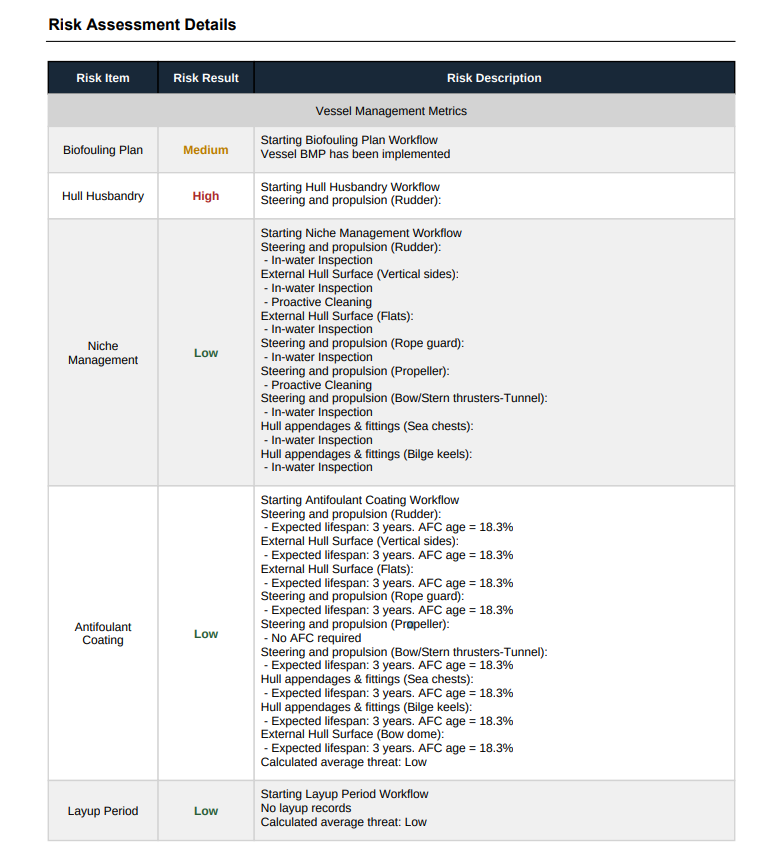

Logs
Step 1: To View Logs click on the Clock Icon.
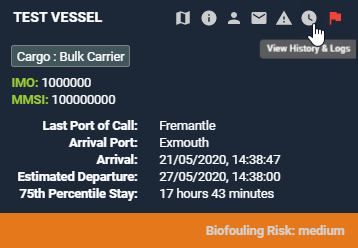
Step 2: View existing Logs.
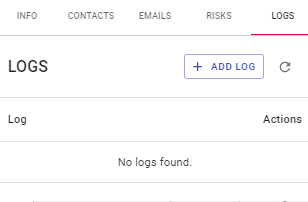
Add Log
Step 1: Click Add Log.

Step 2: Enter Log Type.
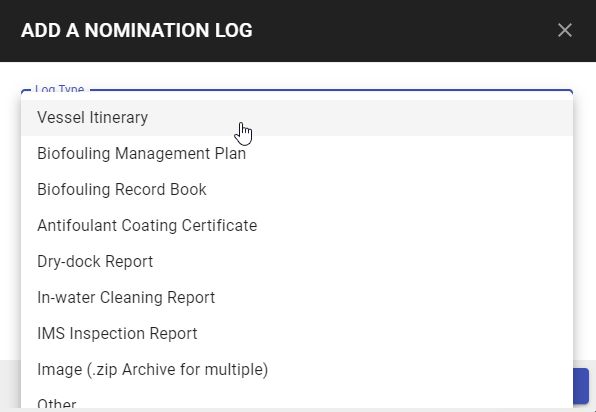
Step 3: Enter description as required.
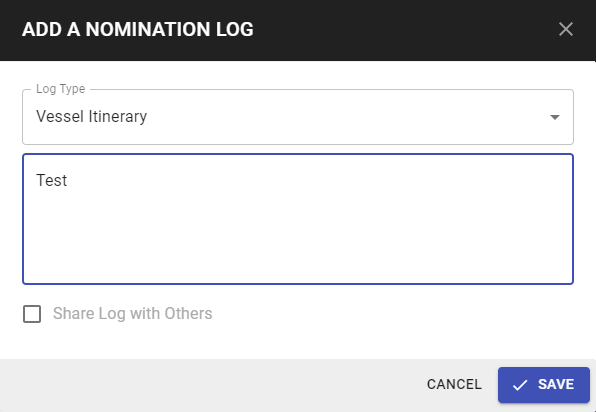
Step 4: Check the Tick box if the Log is able to be shared. By Clicking Share Log the document and Log will be visible by others. Leaving this tick box blank the document and Log will only be visible to the author 'you'. Permissions can be edited at any time using the 'Edit' function.


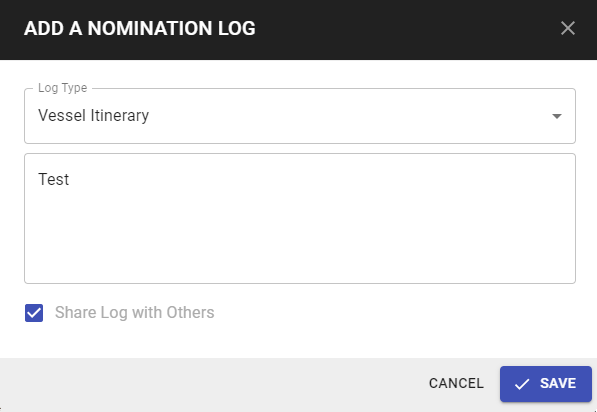
Step 5: Click Save.


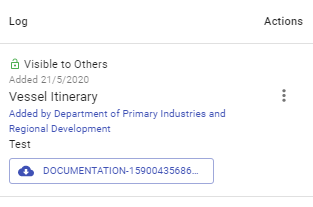
Step 6: Files can only be uploaded once the Log has been created and saved. Upload File.
Click on Actions > Attach Files.
To Drag and drop file, left click on the file and drag to the blue lined box, drop the file.

To upload from Browse files. Click to Select required file. Click Open.
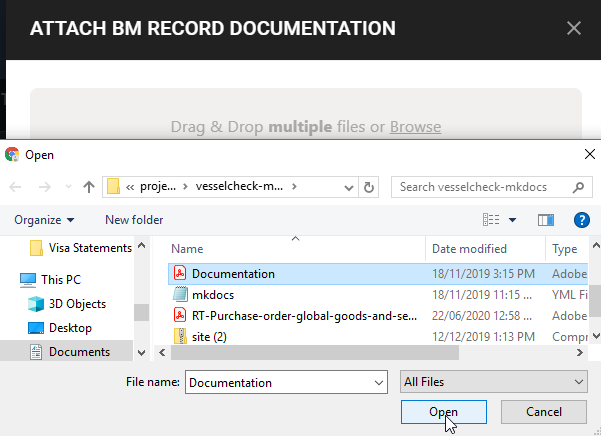
Edit Log
Step 1: Click Actions and Edit.

Step 2: Edit Log as required. Click Save. The updated Log will now appear.
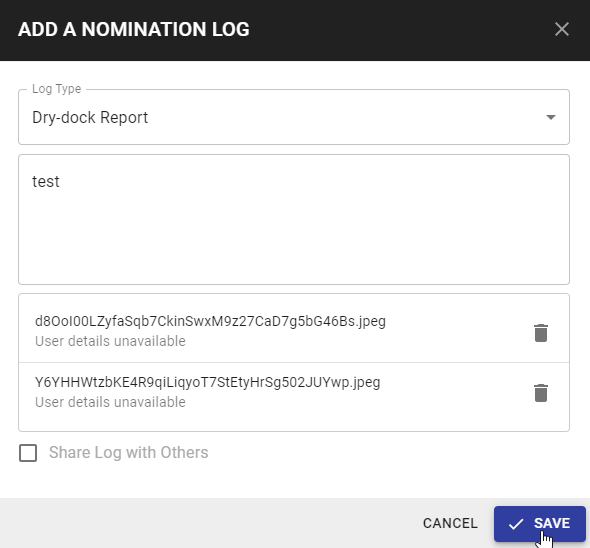
Delete Log
Step 1: Click Actions and Delete.

Step 2: A dialogue box will appear confirming the deletion of the Log. Click Delete.

Flag Information
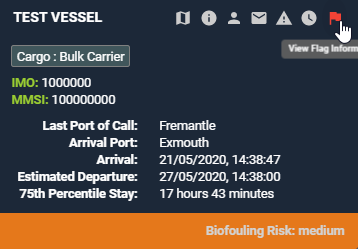
Info
Info includes General information about the Flag on the Vessel. It also displays Organisations that have received the shared flag.
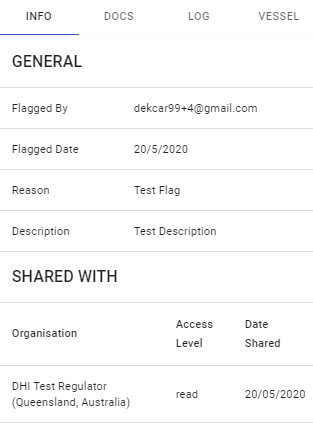
Docs
Docs display uploaded documents to each Flag and show which documents are made visible to other organisations.
Attach More
Step 1: Click Attach More.

Step 2: Enter document details and upload file. Click Save.

Download
Step 1: Click Actions and Download. The specified documents will download.
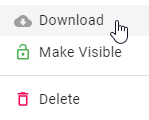
Make Private/ Make Visible
Step 1: Click Actions and Make Private or Make Visible.
Make Visible will share document with organisations that have had the Flag shared to them. Make Private will make the document private will ensure the document is only visible to the uploader. Document permissions can be updated at any time.

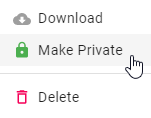
Step 2: Permissions will be updated successfully. Note each document will display permissions.



Delete Document
Please note all documents must be deleted prior to deleting an entire Flag.
Step 1: Click Actions and Delete.

Step 2: A dialogue box will appear confirming the deletion of the document.

Log
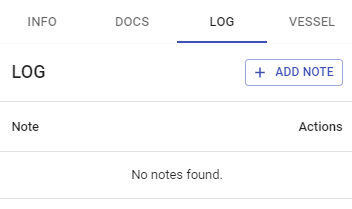
Add Note
Step 1: Click Add Note.

Step 2: Enter Note and Click Save. The Note will be successfully added to the Flag Log. Each note will display the Date, Note details and Note Author.


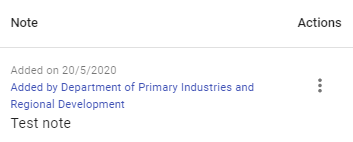
Edit Note
Step 1: Click Actions and Edit.

Step 2: Edit Note as required. Click Save. The updated Note will now appear in the Flag Log.
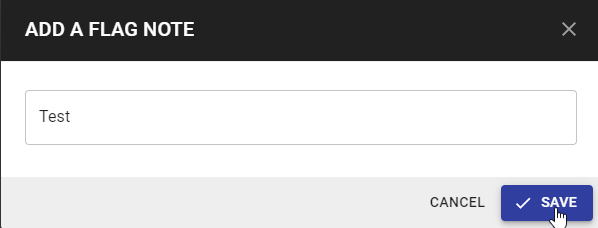
Delete Note
Step 1: Click Actions and Delete.

Step 2: A dialogue box will appear confirming the deletion of the Note. Click Delete.

Vessel
The Vessel tab will display recent AIS data for the Vessel. Please note the Last Report data line, displays up to date AIS data that has been retrieved for the Vessel.
